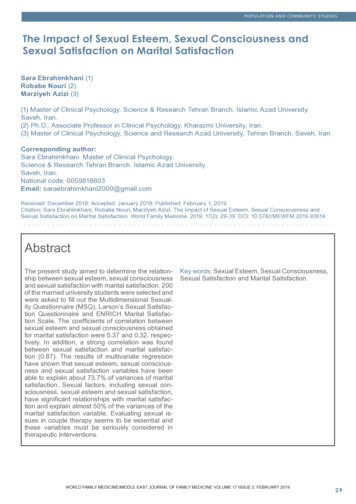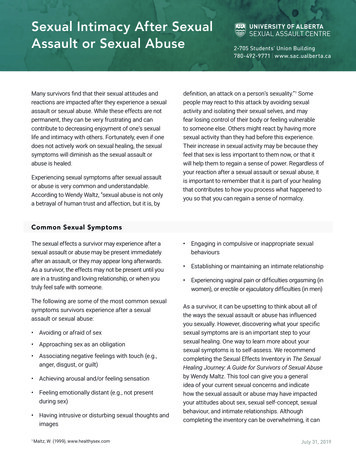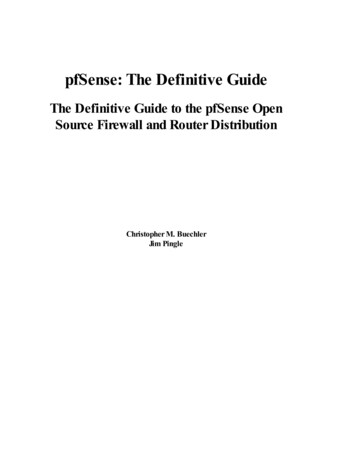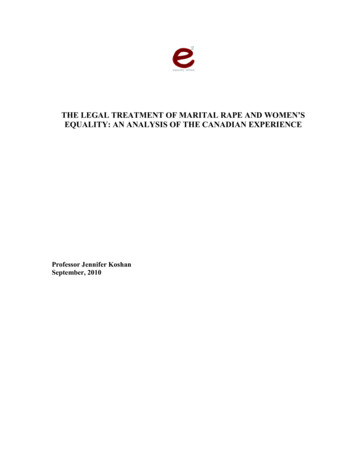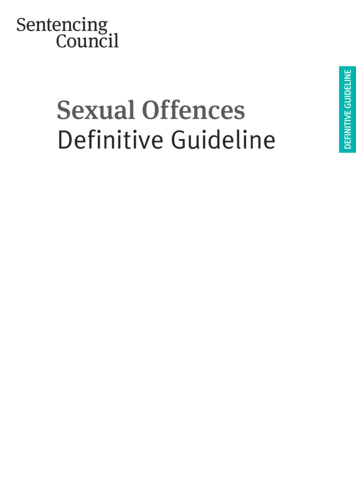
Transcription
DEFINITIVE GUIDELINESexual OffencesDefinitive Guideline
ContentsApplicability of guideline7Rape and assault offences9RapeSexual Offences Act 2003 (section 1)9Assault by penetrationSexual Offences Act 2003 (section 2)13Sexual assaultSexual Offences Act 2003 (section 3)17Causing a person to engage in sexual activity without consentSexual Offences Act 2003 (section 4)21Offences where the victim is a child27Rape of a child under 13Sexual Offences Act 2003 (section 5)27Assault of a child under 13 by penetrationSexual Offences Act 2003 (section 6)33Sexual assault of a child under 13Sexual Offences Act 2003 (section 7)37Causing or inciting a child under 13 to engage in sexual activitySexual Offences Act 2003 (section 8)41Sexual activity with a childSexual Offences Act 2003 (section 9)45Causing or inciting a child to engage in sexual activitySexual Offences Act 2003 (section 10)45Sexual activity with a child family memberSexual Offences Act 2003 (section 25)51Inciting a child family member to engage in sexual activitySexual Offences Act 2003 (section 26)51Engaging in sexual activity in the presence of a childSexual Offences Act 2003 (section 11)57Effective from 1 April 2014
2 Sexual Offences Definitive GuidelineCausing a child to watch a sexual actSexual Offences Act 2003 (section 12)57Arranging or facilitating the commission of a child sex offenceSexual Offences Act 2003 (section 14)61Meeting a child following sexual groomingSexual Offences Act 2003 (section 15)63Abuse of position of trust: sexual activity with a childSexual Offences Act 2003 (section 16)67Abuse of position of trust: causing or inciting a child to engage in sexual activitySexual Offences Act 2003 (section 17)67Abuse of position of trust: sexual activity in the presence of a childSexual Offences Act 2003 (section 18)71Abuse of position of trust: causing a child to watch a sexual actSexual Offences Act 2003 (section 19)71Indecent images of children75Possession of indecent photograph of childCriminal Justice Act 1988 (section 160)75Indecent photographs of childrenProtection of Children Act 1978 (section 1)75Exploitation offences81Causing or inciting prostitution for gainSexual Offences Act 2003 (section 52)81Controlling prostitution for gainSexual Offences Act 2003 (section 53)81Keeping a brothel used for prostitutionSexual Offences Act 1956 (section 33A)85Causing or inciting sexual exploitation of a childSexual Offences Act 2003 (section 48)89Controlling a child in relation to sexual exploitationSexual Offences Act 2003 (section 49)89Arranging or facilitating sexual exploitation of a childSexual Offences Act 2003 (section 50)89Effective from 1 April 2014
Sexual Offences Definitive Guideline 3Paying for the sexual services of a childSexual Offences Act 2003 (section 47)95Trafficking people for sexual exploitationSexual Offences Act 2003 (sections 59A)99Offences against those with a mental disorder103Sexual activity with a person with a mental disorder impeding choiceSexual Offences Act 2003 (section 30)103Causing or inciting a person, with a mental disorder impeding choice,to engage in sexual activitySexual Offences Act 2003 (section 31)103Engaging in sexual activity in the presence of a person with mental disorderimpeding choiceSexual Offences Act 2003 (section 32)109Causing a person, with mental disorder impeding choice, to watch a sexual actSexual Offences Act 2003 (section 33)109Inducement, threat or deception to procure sexual activitywith a person with a mental disorderSexual Offences Act 2003 (section 34)113Causing a person with a mental disorder to engage in or agree to engagein sexual activity by inducement, threat or deceptionSexual Offences Act 2003 (section 35)113Engaging in sexual activity in the presence, procured by inducement,threat or deception, of a person with a mental disorderSexual Offences Act 2003 (section 36)117Causing a person with a mental disorder to watch a sexual act by inducement,threat or deceptionSexual Offences Act 2003 (section 37)117Care workers: sexual activity with a person with a mental disorderSexual Offences Act 2003 (section 38)121Care workers: causing or inciting sexual activitySexual Offences Act 2003 (section 39)121Care workers: sexual activity in the presence of a person with a mental disorderSexual Offences Act 2003 (section 40)125Care workers: causing a person with a mental disorder to watch a sexual actSexual Offences Act 2003 (section 41)125Effective from 1 April 2014
4 Sexual Offences Definitive GuidelineOther sexual offences129ExposureSexual Offences Act 2003 (section 66)129VoyeurismSexual Offences Act 2003 (section 67)133Sex with an adult relative: penetrationSexual Offences Act 2003 (section 64)137Sex with an adult relative: consenting to penetrationSexual Offences Act 2003 (section 65)137Administering a substance with intentSexual Offences Act 2003 (section 61)141Committing an offence with intent to commit a sexual offenceSexual Offences Act 2003 (section 62)145Trespass with intent to commit a sexual offenceSexual Offences Act 2003 (section 63)147Guidance regarding offences committed by offendersunder the age of 18 (no definitive guidelines are included)151Child sex offences committed by children or young persons (sections 9–12)(offender under 18)Sexual Offences Act 2003 (section 13)151Sexual activity with a child family member (offender under 18)Sexual Offences Act 2003 (section 25)151Inciting a child family member to engage in sexual activity (offender under 18)Sexual Offences Act 2003 (section 26)151Effective from 1 April 2014
Sexual Offences Definitive Guideline 5Annex A: Ancillary ordersAutomatic orders on conviction153154Annex B: Approach to sentencing historic sexual offences155Annex C: Historic offences157Annex D: Fine bands and community orders160 Crown copyright 2013You may re-use this information (not including logos) free of charge in any format or medium, under the terms of theOpen Government Licence. To view this licence, visit cence/or email: psi@nationalarchives.gsi.gov.ukEffective from 1 April 2014
6 Sexual Offences Definitive GuidelineBlank pageEffective from 1 April 2014
Sexual Offences Definitive Guideline 7Applicability of guidelineIn accordance with section 120 of the Coronersand Justice Act 2009, the Sentencing Councilissues this definitive guideline. It appliesto all offenders aged 18 and older, who aresentenced on or after 1 April 2014.Section 125(1) of the Coroners and Justice Act 2009provides that when sentencing offences committedon or after 6 April 2010:“Every court –(a) must, in sentencing an offender, follow anysentencing guideline which is relevant to theoffender’s case, and(b) must, in exercising any other function relatingto the sentencing of offenders, follow anysentencing guidelines which are relevant to theexercise of the function,unless the court is satisfied that it would becontrary to the interests of justice to do so.”This guideline applies only to offenders aged 18and older. General principles to be considered inthe sentencing of youths are in the SentencingGuidelines Council’s definitive guideline,Overarching Principles – Sentencing Youths.Structure, ranges and starting pointsFor the purposes of section 125(3)–(4) of theCoroners and Justice Act 2009, the guidelinespecifies offence ranges – the range of sentencesappropriate for each type of offence. Withineach offence, the Council has specified differentcategories which reflect varying degrees ofseriousness. The offence range is split into categoryranges – sentences appropriate for each levelof seriousness. The Council has also identified astarting point within each category.Starting points define the position within acategory range from which to start calculating theprovisional sentence. Starting points apply toall offences within the corresponding categoryand are applicable to all offenders, in all cases.Once the starting point is established, the courtshould consider further aggravating and mitigatingfactors and previous convictions so as to adjustthe sentence within the range. Starting points andranges apply to all offenders, whether they havepleaded guilty or been convicted after trial. Creditfor a guilty plea is taken into consideration only atstep four in the decision making process, after theappropriate sentence has been identified.Information on ancillary orders is set out at Annex Aon page 153. Information on historic offences is setout at Annexes B and C on pages 155 and 157.Information on community orders and fine bands isset out at Annex D on page 160.Effective from 1 April 2014
8 Sexual Offences Definitive GuidelineBlank pageEffective from 1 April 2014
Sexual Offences Definitive Guideline 9Sexual Offences Act 2003 (section 1)Triable only on indictmentMaximum: Life imprisonmentOffence range: 4 – 19 years’ custodyThis is a serious specified offence for the purposes of sections 224 and 225(2) (life sentence forserious offences) of the Criminal Justice Act 2003.For offences committed on or after 3 December 2012, this is an offence listed in Part 1 of Schedule15B for the purposes of sections 224A (life sentence for second listed offence) of the CriminalJustice Act 2003.For convictions on or after 3 December 2012 (irrespective of the date of commission of theoffence), this is a specified offence for the purposes of section 226A (extended sentence forcertain violent or sexual offences) of the Criminal Justice Act 2003.Effective from 1 April 2014RAPERape
10 Sexual Offences Definitive GuidelineSTEP ONEDetermining the offence categoryRAPEThe court should determine which categories of harm and culpability the offence falls into by referenceonly to the tables below.Offences may be of such severity, for example involving a campaign of rape, that sentences of20 years and above may be appropriate.CulpabilityHarmCategory 1Category 2The extreme nature of one or morecategory 2 factors or the extreme impactcaused by a combination of category 2factors may elevate to category 1 Severe psychological or physical harm Pregnancy or STI as a consequence ofoffence Additional degradation/humiliation Abduction Prolonged detention/sustainedincident Violence or threats of violence (beyondthat which is inherent in the offence) Forced/uninvited entry into victim’shome Victim is particularly vulnerable due topersonal circumstances** for children under 13 please refer to theguideline on page 27Category 3Factor(s) in categories 1 and 2 not presentASignificant degree of planningOffender acts together with others to commit the offenceUse of alcohol/drugs on victim to facilitate the offenceAbuse of trustPrevious violence against victimOffence committed in course of burglaryRecording of the offenceCommercial exploitation and/or motivationOffence racially or religiously aggravatedOffence motivated by, or demonstrating, hostility to thevictim based on his or her sexual orientation (or presumedsexual orientation) or transgender identity (or presumedtransgender identity)Offence motivated by, or demonstrating, hostility to thevictim based on his or her disability (or presumed disability)BFactor(s) in category A not presentSTEP TWOStarting point and category rangeHaving determined the category, the court should use the corresponding starting points to reacha sentence within the category range on the next page. The starting point applies to all offendersirrespective of plea or previous convictions. Having determined the starting point, step two allows furtheradjustment for aggravating or mitigating features set out on the next page.A case of particular gravity, reflected by multiple features of culpability or harm in step one, could meritupward adjustment from the starting point before further adjustment for aggravating or mitigatingfeatures, set out on the next page.Effective from 1 April 2014
ABStarting point15 years’ custodyStarting point12 years’ custodyCategory range13 – 19 years’ custodyCategory range10 – 15 years’ custodyStarting point10 years’ custodyStarting point8 years’ custodyCategory range9 – 13 years’ custodyCategory range7 – 9 years’ custodyStarting point7 years’ custodyStarting point5 years’ custodyCategory range6 – 9 years’ custodyCategory range4 – 7 years’ custodyCategory 1Category 2Category 3The table below contains a non-exhaustive list of additional factual elements providing the context of theoffence and factors relating to the offender. Identify whether any combination of these, or other relevantfactors, should result in an upward or downward adjustment from the starting point. In particular,relevant recent convictions are likely to result in an upward adjustment. In some cases, havingconsidered these factors, it may be appropriate to move outside the identified category range.Aggravating factorsAttempts to dispose of or conceal evidenceStatutory aggravating factorsCommission of offence whilst under the influence of alcoholor drugsPrevious convictions, having regard to a) the nature of theoffence to which the conviction relates and its relevance tothe current offence; and b) the time that has elapsed sincethe convictionMitigating factorsOffence committed whilst on bailNo previous convictions or no relevant/recent convictionsOther aggravating factorsRemorseSpecific targeting of a particularly vulnerable victimPrevious good character and/or exemplary conduct*Ejaculation (where not taken into account at step one)Age and/or lack of maturity where it affects theresponsibility of the offenderBlackmail or other threats made (where not taken intoaccount at step one)Location of offenceTiming of offenceUse of weapon or other item to frighten or injureVictim compelled to leave their home (including victims ofdomestic violence)Failure to comply with current court ordersOffence committed whilst on licenceExploiting contact arrangements with a child to commit anoffencePresence of others, especially childrenAny steps taken to prevent the victim reporting an incident,obtaining assistance and/or from assisting or supportingthe prosecutionEffective from 1 April 2014Mental disorder or learning disability, particularly wherelinked to the commission of the offence* Previous good character/exemplary conduct is different from having noprevious convictions. The more serious the offence, the less the weightwhich should normally be attributed to this factor. Where previous goodcharacter/exemplary conduct has been used to facilitate the offence,this mitigation should not normally be allowed and such conduct mayconstitute an aggravating factor.In the context of this offence, previous good character/exemplary conductshould not normally be given any significant weight and will not normallyjustify a reduction in what would otherwise be the appropriate sentence.RAPESexual Offences Definitive Guideline 11
12 Sexual Offences Definitive GuidelineSTEP THREERAPEConsider any factors which indicate a reduction, such as assistance to the prosecutionThe court should take into account sections 73 and 74 of the Serious Organised Crime and Police Act2005 (assistance by defendants: reduction or review of sentence) and any other rule of law by virtue ofwhich an offender may receive a discounted sentence in consequence of assistance given (or offered) tothe prosecutor or investigator.STEP FOURReduction for guilty pleasThe court should take account of any potential reduction for a guilty plea in accordance with section 144of the Criminal Justice Act 2003 and the Guilty Plea guideline.STEP FIVEDangerousnessThe court should consider whether having regard to the criteria contained in Chapter 5 of Part 12 ofthe Criminal Justice Act 2003 it would be appropriate to award a life sentence (section 224A or section225(2)) or an extended sentence (section 226A). When sentencing offenders to a life sentence underthese provisions, the notional determinate sentence should be used as the basis for the setting of aminimum term.STEP SIXTotality principleIf sentencing an offender for more than one offence, or where the offender is already serving a sentence,consider whether the total sentence is just and proportionate to the offending behaviour.STEP SEVENAncillary ordersThe court must consider whether to make any ancillary orders. The court must also consider what otherrequirements or provisions may automatically apply. Further information is included at Annex A onpage 153.STEP EIGHTReasonsSection 174 of the Criminal Justice Act 2003 imposes a duty to give reasons for, and explain the effect of,the sentence.STEP NINEConsideration for time spent on bailThe court must consider whether to give credit for time spent on bail in accordance with section 240A ofthe Criminal Justice Act 2003.Effective from 1 April 2014
Assault by penetrationSexual Offences Act 2003 (section 2)Triable only on indictmentMaximum: Life imprisonmentOffence range: Community order – 19 years’ custodyThis is a serious specified offence for the purposes of sections 224 and 225(2) (life sentence forserious offences) of the Criminal Justice Act 2003.For offences committed on or after 3 December 2012, this is an offence listed in Part 1 of Schedule15B for the purposes of sections 224A (life sentence for second listed offence) of the CriminalJustice Act 2003.For convictions on or after 3 December 2012 (irrespective of the date of commission of theoffence), this is a specified offence for the purposes of section 226A (extended sentence forcertain violent or sexual offences) of the Criminal Justice Act 2003Effective from 1 April 2014ASSAULT BY PENETRATIONSexual Offences Definitive Guideline 13
14 Sexual Offences Definitive GuidelineSTEP ONEASSAULT BY PENETRATIONDetermining the offence categoryThe court should determine which categories of harm and culpability the offence falls into by referenceonly to the tables below.HarmCategory 1Category 2CulpabilityThe extreme nature of one or morecategory 2 factors or the extreme impactcaused by a combination of category 2factors may elevate to category 1 Severe psychological or physical harm Penetration using large or dangerousobject(s) Additional degradation/humiliation Abduction Prolonged detention/sustainedincident Violence or threats of violence (beyondthat which is inherent in the offence) Forced/uninvited entry into victim’shome Victim is particularly vulnerable due topersonal circumstances** for children under 13 please refer to theguideline on page 33Category 3Factor(s) in categories 1 and 2 not presentASignificant degree of planningOffender acts together with others to commit the offenceUse of alcohol/drugs on victim to facilitate the offenceAbuse of trustPrevious violence against victimOffence committed in course of burglaryRecording of the offenceCommercial exploitation and/or motivationOffence racially or religiously aggravatedOffence motivated by, or demonstrating, hostility to thevictim based on his or her sexual orientation (or presumedsexual orientation) or transgender identity (or presumedtransgender identity)Offence motivated by, or demonstrating, hostility to thevictim based on his or her disability (or presumed disability)BFactor(s) in category A not presentSTEP TWOStarting point and category rangeHaving determined the category, the court should use the corresponding starting points to reacha sentence within the category range on the next page. The starting point applies to all offendersirrespective of plea or previous convictions.Having determined the starting point, step two allows further adjustment for aggravating or mitigatingfeatures, set out on the next page.A case of particular gravity, reflected by multiple features of culpability or harm in step one, could meritupward adjustment from the starting point before further adjustment for aggravating or mitigatingfeatures, set out on the next page.Where there is a sufficient prospect of rehabilitation, a community order with a sex offender treatmentprogramme requirement under section 202 of the Criminal Justice Act 2003 can be a proper alternative toa short or moderate length custodial sentence.Effective from 1 April 2014
ABStarting point15 years’ custodyStarting point12 years’ custodyCategory range13 – 19 years’ custodyCategory range10 – 15 years’ custodyStarting point8 years’ custodyStarting point6 years’ custodyCategory range5 – 13 years’ custodyCategory range4 – 9 years’ custodyStarting point4 years’ custodyStarting point2 years’ custodyCategory range2 – 6 years’ custodyCategory rangeHigh level community order – 4 years’ custodyCategory 1Category 2Category 3The table below contains a non-exhaustive list of additional factual elements providing the context of theoffence and factors relating to the offender. Identify whether any combination of these, or other relevantfactors, should result in an upward or downward adjustment from the starting point. In particular,relevant recent convictions are likely to result in an upward adjustment. In some cases, havingconsidered these factors, it may be appropriate to move outside the identified category range.When sentencing appropriate category 3 offences, the court should also consider the custody thresholdas follows: has the custody threshold been passed? if so, is it unavoidable that a custodial sentence be imposed? if so, can that sentence be suspended?Aggravating factorsStatutory aggravating factorsPrevious convictions, having regard to a) the nature of theoffence to which the conviction relates and its relevance tothe current offence; and b) the time that has elapsed sincethe convictionAny steps taken to prevent the victim reporting an incident,obtaining assistance and/or from assisting or supportingthe prosecutionAttempts to dispose of or conceal evidenceCommission of offence whilst under the influence of alcoholor drugsOffence committed whilst on bailOther aggravating factorsMitigating factorsSpecific targeting of a particularly vulnerable victimNo previous convictions or no relevant/recent convictionsBlackmail or other threats made (where not taken intoaccount at step one)RemorseLocation of offenceAge and/or lack of maturity where it affects theresponsibility of the offenderTiming of offenceUse of weapon or other item to frighten or injureVictim compelled to leave their home (including victims ofdomestic violence)Failure to comply with current court ordersOffence committed whilst on licenceExploiting contact arrangements with a child to commit anoffencePresence of others, especially childrenEffective from 1 April 2014Previous good character and/or exemplary conduct*Mental disorder or learning disability, particularly wherelinked to the commission of the offence* Previous good character/exemplary conduct is different from having noprevious convictions. The more serious the offence, the less the weightwhich should normally be attributed to this factor. Where previous goodcharacter/exemplary conduct has been used to facilitate the offence,this mitigation should not normally be allowed and such conduct mayconstitute an aggravating factor.In the context of this offence, previous good character/exemplary conductshould not normally be given any significant weight and will not normallyjustify a reduction in what would otherwise be the appropriate sentence.ASSAULT BY PENETRATIONSexual Offences Definitive Guideline 15
16 Sexual Offences Definitive GuidelineASSAULT BY PENETRATIONSTEP THREEConsider any factors which indicate a reduction, such as assistance to the prosecutionThe court should take into account sections 73 and 74 of the Serious Organised Crime and Police Act2005 (assistance by defendants: reduction or review of sentence) and any other rule of law by virtue ofwhich an offender may receive a discounted sentence in consequence of assistance given (or offered) tothe prosecutor or investigator.STEP FOURReduction for guilty pleasThe court should take account of any potential reduction for a guilty plea in accordance with section 144of the Criminal Justice Act 2003 and the Guilty Plea guideline.STEP FIVEDangerousnessThe court should consider whether having regard to the criteria contained in Chapter 5 of Part 12 ofthe Criminal Justice Act 2003 it would be appropriate to award a life sentence (section 224A or section225(2)) or an extended sentence (section 226A). When sentencing offenders to a life sentence underthese provisions, the notional determinate sentence should be used as the basis for the setting of aminimum term.STEP SIXTotality principleIf sentencing an offender for more than one offence, or where the offender is already serving a sentence,consider whether the total sentence is just and proportionate to the offending behaviour.STEP SEVENAncillary ordersThe court must consider whether to make any ancillary orders. The court must also consider what otherrequirements or provisions may automatically apply. Further information is included at Annex A onpage 153.STEP EIGHTReasonsSection 174 of the Criminal Justice Act 2003 imposes a duty to give reasons for, and explain the effect of,the sentence.STEP NINEConsideration for time spent on bailThe court must consider whether to give credit for time spent on bail in accordance with section 240A ofthe Criminal Justice Act 2003.Effective from 1 April 2014
Sexual assaultSexual Offences Act 2003 (section 3)Triable either wayMaximum: 10 years’ custodyOffence range: Community order – 7 years’ custodyFor convictions on or after 3 December 2012 (irrespective of the date of commission of theoffence), this is a specified offence for the purposes of section 226A (extended sentence forcertain violent or sexual offences) of the Criminal Justice Act 2003.Effective from 1 April 2014SEXUAL ASSAULTSexual Offences Definitive Guideline 17
18 Sexual Offences Definitive GuidelineSTEP ONESEXUAL ASSAULTDetermining the offence categoryThe court should determine which categories of harm and culpability the offence falls into by referenceonly to the tables below.HarmCategory 1Category 2Category 3Culpability Severe psychological or physical harmAbductionViolence or threats of violenceForced/uninvited entry into victim’shomeASignificant degree of planningOffender acts together with others to commit the offence Touching of naked genitalia or nakedbreasts Prolonged detention/sustainedincident Additional degradation/humiliation Victim is particularly vulnerable due topersonal circumstances*Use of alcohol/drugs on victim to facilitate the offence* for children under 13 please refer to theguideline on page 37Commercial exploitation and/or motivationFactor(s) in categories 1 and 2 not presentAbuse of trustPrevious violence against victimOffence committed in course of burglaryRecording of offenceOffence racially or religiously aggravatedOffence motivated by, or demonstrating, hostility to thevictim based on his or her sexual orientation (or presumedsexual orientation) or transgender identity (or presumedtransgender identity)Offence motivated by, or demonstrating, hostility to thevictim based on his or her disability (or presumed disability)BFactor(s) in category A not presentSTEP TWOStarting point and category rangeHaving determined the category, the court should use the corresponding starting points to reacha sentence within the category range on the next page. The starting point applies to all offendersirrespective of plea or previous convictions. Having determined the starting point, step two allows furtheradjustment for aggravating or mitigating features, set out on the next page.A case of particular gravity, reflected by multiple features of culpability or harm in step one, could meritupward adjustment from the starting point before further adjustment for aggravating or mitigatingfeatures, set out on the next page.Where there is a sufficient prospect of rehabilitation, a community order with a sex offender treatmentprogramme requirement under section 202 of the Criminal Justice Act 2003 can be a proper alternative toa short or moderate length custodial sentence.Effective from 1 April 2014
ABStarting point4 years’ custodyStarting point2 years 6 months’ custodyCategory range3 – 7 years’ custodyCategory range2 – 4 years’ custodyStarting point2 years’ custodyStarting point1 year’s custodyCategory range1 – 4 years’ custodyCategory rangeHigh level community order – 2 years’ custodyStarting point26 weeks’ custodyStarting pointHigh level community orderCategory rangeHigh level community order –1 year’s custodyCategory rangeMedium level community order –26 weeks’ custodyCategory 1Category 2Category 3The table below contains a non-exhaustive list of additional factual elements providing the context of theoffence and factors relating to the offender. Identify whether any combination of these, or other relevantfactors, should result in an upward or downward adjustment from the starting point. In particular,relevant recent convictions are likely to result in an upward adjustment. In some cases, havingconsidered these factors, it may be appropriate to move outside the identified category range.When sentencing appropriate category 2 or 3 offences, the court should also consider the custodythreshold as follows: has the custody threshold been passed? if so, is it unavoidable that a custodial sentence be imposed? if so, can that sentence be suspended?Aggravating factorsStatutory aggravating factorsPrevious convictions, having regard to a) the nature of theoffence to which the conviction relates and its relevance tothe current offence; and b) the time that has elapsed sincethe convictionAny steps taken to prevent the victim reporting an incident,obtaining assistance and/or from assisting or supportingthe prosecutionAttempts to dispose of or conceal evidenceCommission of offence whilst under the influence of alcoholor drugsOffence committed whilst on bailOther aggravating factorsMitigating factorsSpecific targeting of a particularly vulnerable victimNo previous convictions or no relevant/recent co
Sexual Offences Definitive Guideline 7, Effective from 1 April 2014, Applicability of guideline, I, n accordance with section 120 of the Coroners , and Justice Act 2009, the Sentencing Council issues this definitive guideline. It applies to all offenders aged 18 and older, who are sentenced on or after 1 April 2014.




